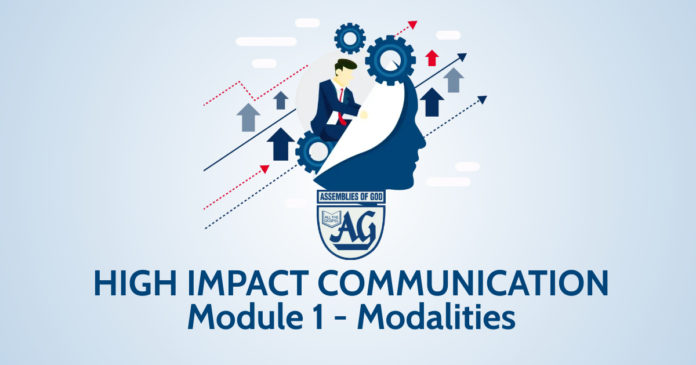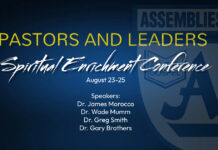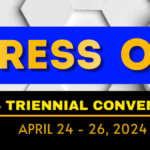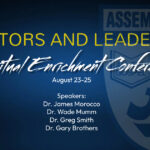“People are unique” A fact that is as common as the air we breathe. This is one of the basic concepts that society has taught at the earliest stage of one’s life. Gender, nationality, social status, vocation. These are just some of the ways that differentiate people. But what a lot of us don’t know is that people each have a different way to process and understand information.
For a time, the misconception about communication was that there is just one process to it. The speaker has a message and sends it to the recipient. However, by understanding the different ways that people take in information creates an opportunity to let your message hit home. And in the ministry, a lot of what we do is centered on communicating.
Take for example how people would respond to a new device (like a mobile phone or any electronic gadget) they were able to purchase. There are people who would instantly study the manual, the box and all the papers that come with it. Some would call someone over to have them explain in detail all the features of the device and the things that they need to know about it. While some would just pick up the device and explore it.
This shows us that there are 3 major avenues of processing information and they are called Modalities. Modalities are based on how people experience the world through the different senses like touch, sound and touch. This also affects the learning behaviors of different people. By tapping into the people’s default modality, you are able to engage with them on a deeper level to get your message across.
You can gauge the modality of the person you are talking to through a couple of factors.
- Communication Style – Their preferred way of taking in communication
- Language – The words, tone and pitch when people talk reflect their modality.
- Physiology – Their general body language
Here are the 3 modalities:
- Visual – People who have a visual modality are particular with what they see.
Communication Style: They would prefer a text message, an email or any written document over a phone call. They like to see text or a good blend between colors. Visual people love to learn through what they read in a book, pamphlet or Powerpoint presentations.
Language: “A picture paints a thousand words” which is why visual people may have the tendency to talk fast. This is because they try to describe things in as much detail as they can. They would use words like “This is crystal clear to me”, “I see where you’re coming from”.
Physiology: Visual people are very particular about appearances as well. This is how you can actually spot if a person is visual: by the way he/she presents themselves. They put in a huge effort on how they look. And because appearances are important, they tend to avoid using any gestures and in the times that they do, their movements tend to be small and calculated.
2.) Auditory – the main channel of communication for auditory people is what sound. What they hear and how they sound like.
Communication Style: Their preference would go to conversations, calls, audiobooks and just about any learning material that has something to do with how things sound over materials with text or pictures.
Language: An auditory person would not just make sure that he/she sounds good in terms of the acoustics in the voice, but would also have a rich and intricate vocabulary. To put it simply, they like to sound good and use complex words.
Physiology: The tendency of auditory people is they do not present themselves visually as good as they sound. They are somewhat expressive with their hand movements and may use different sounds (like sound effects) to go along with the words that they use.
3.) Kinesthetic – these are the people who “like to wear their hearts on their sleeves”. They are very connected to how they feel and would use body language to great effect in their communication.
Communication Style: Because kinesthetic people are more connected to their sense of touch, they like tactile and physical activities. They learn faster by actually doing something over concepts. They also like physical body gestures with others like a high five, a tap on the shoulder and handshakes.
NOTE: When it comes to physical touch, Kinesthetic people can play within extremes. They would either love to exchange physical touch/gestures or they would prefer not to have them at all. An effective way to find out whether or not it would be ok to give a Kinesthetic person a physical gesture like a tap on the shoulder or on the hand is if they would give the gesture first.
Language: Kinesthetic people are so attuned with how they feel this comes out as well in the way they speak. Conversations you may have with them may be a really passionate and energetic interaction or a more subtle and calm exchange. Whatever the case, they are ones who would speak from the heart and you can really tell what they are feeling through the words they use: “I am so pumped to do this!”, “Let’s get going with this, we’re going to smash it!”.
Physiology: Kinesthetic people have a tendency to use a lot of gestures. Their gestures can tend to be really big as body language plays a huge part of their communication process.
Now when talking to crowds, it is best to exhibit all modalities in your presentations since there will be a mix of all 3 within your audience. So have a clear powerpoint presentation, expand your vocabulary for access to more words you can use and utilizing small physical activities (e.g. having them look to the person on their right, encouraging them to clap) goes a long way in having your audience engaged.
The main point here is that Communication is not a one-size-fits-all. We should learn to adapt to the person that we are talking to so that we can be able to effectively convey our message. And no message is more important than God’s word.
Another detail to remember that the knowledge of this is not meant to box you into a certain category. As long as we have the sense of touch, sight and sound then we can exhibit ALL modalities. There was just 1 modality that got more developed than the rest. The key here is developing the skill to adapt to any person that you get to interact with.



















